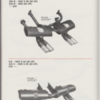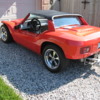The term sidewinder refers to the orientation of the header tubing going across (from left to right) into the collector. Henry used 2 mufflers to quieten down the exhaust noise for his customers. There's no reason you can't build a section to look like a stock 356 muffler that goes around the last part of the exhaust tubing with the tips coming through.
That's it exactly - "Sidewinder" is the layout of the header. A1 sidewinder headers are available from any number of places, including direct from Tiger. I got two custom headers out of Tiger (collector further back to clear a dry-sump) and it took almost a year in both instances. He's a good guy, but he's busy doing things his way.
Regarding the A1 Sidewinder header: His collector is second to none. The primaries are not equal length, and they're too long to be optimal - but "optimal" points the collector straight out the back. When I was going down this rabbit hole, I talked to John Connelly about it (John was a ME who quit to start a VW parts business, no longer in business). John said, "you know - optimal is great, but an exhaust has to work acceptably well and still fit the car. It also has to be quiet enough to be drivable". It was good advice - the location of the engine and the layout of the package make "perfect" impossible. We get what we get, and don't throw a fit.
Exhaust tuning is pretty cool, and if you read the section covering it in the A. Graham Bell book I referenced, you'll feel like a small child in a physics class. There's not a lot new under the sun.
The thing about a true 4/1 header (as opposed to a can collector) is that because of the Bernoulli effect, a properly constructed and sized collector will actually draw a vacuum on the closed exhaust valve of any particular cylinder. Forget the nonsense about "back pressure" - this vacuum is what makes an engine with cam overlap (both valves open at the same time) even run, and it's very, very strong. Optimizing that vacuum is what exhaust tuning is all about. As I said two paragraphs above - we're not going to get to completely optimal under all conditions because of packaging limitations, and because a perfect header for making power at 7000 RPM is not the same configuration as one making power at 3000 RPM. Creating a nice wide powerband is where the magic is, but everything in life is a compromise. Again, we get what we get, and don't throw a fit.
The outlet size of the collector is super-important. Tiger's headers are built so that what happens after the outlet isn't nearly as important as if the collector outlet was full sized. What you'll see if you get one from Tiger, @Teammccalla, is that the ID of the collector is pretty small - the collector cone is long and at the appropriate optimal angle, but you'll need to blow up from there. This is the "normal" way a good VW header is built (small collector), but not normal for V8 headers or the cheesy EMPI headers with no real collectors -- so if that is your frame of reference, they'll look wrong. What you want is to blow up to a long 2-1/2" pipe, or a shorter pipe dumping into a chamber. A Porsche/Vintage Speed/Bursch style "can" is fine, but a chambered muffler works too, as does the big wide world (if you can stand the sound). I love the sound, so that's what I do (with an exhaust cut-out).
Henry's pictured design was ideal because Magnaflow mufflers (and glass-packs in general) work just like a straight pipe, and there's nothing as sweet-sounding (no droning, mellow sound, nice "bark") as a long, straight pipe with a couple of glass packs in line. With the can, you never know what you'll get as far as a sound, but the look is right (if that's important). The sound might be great with a short pipe going into it or it might not. It'll sound good with a long pipe no matter what.
I built one almost exactly like the one pictured about 10 years back. The sound and performance is great, but you'll need to drop it every time you adjust the valves. I don't think that's a big deal, but there are those who think it is.
















